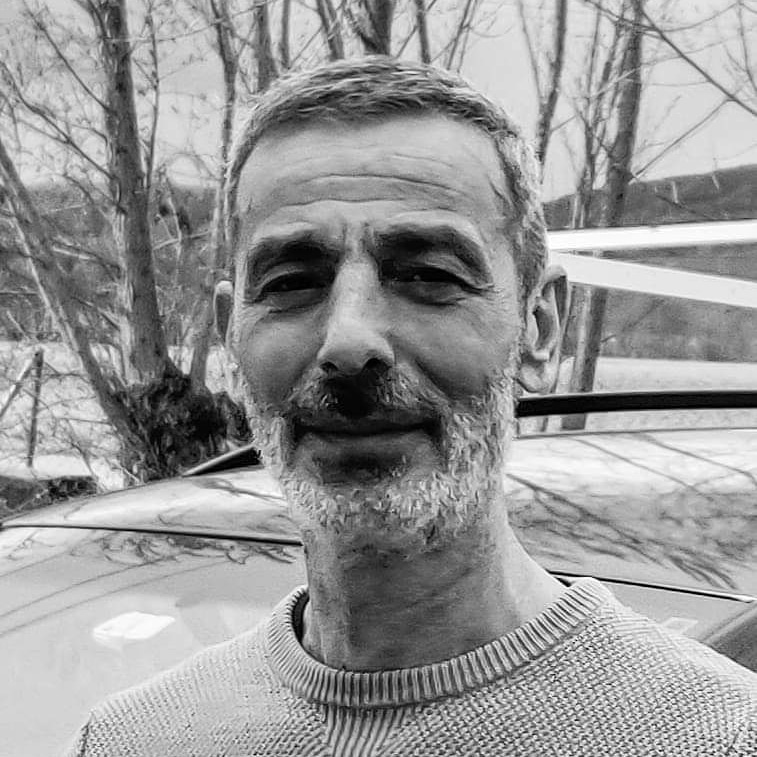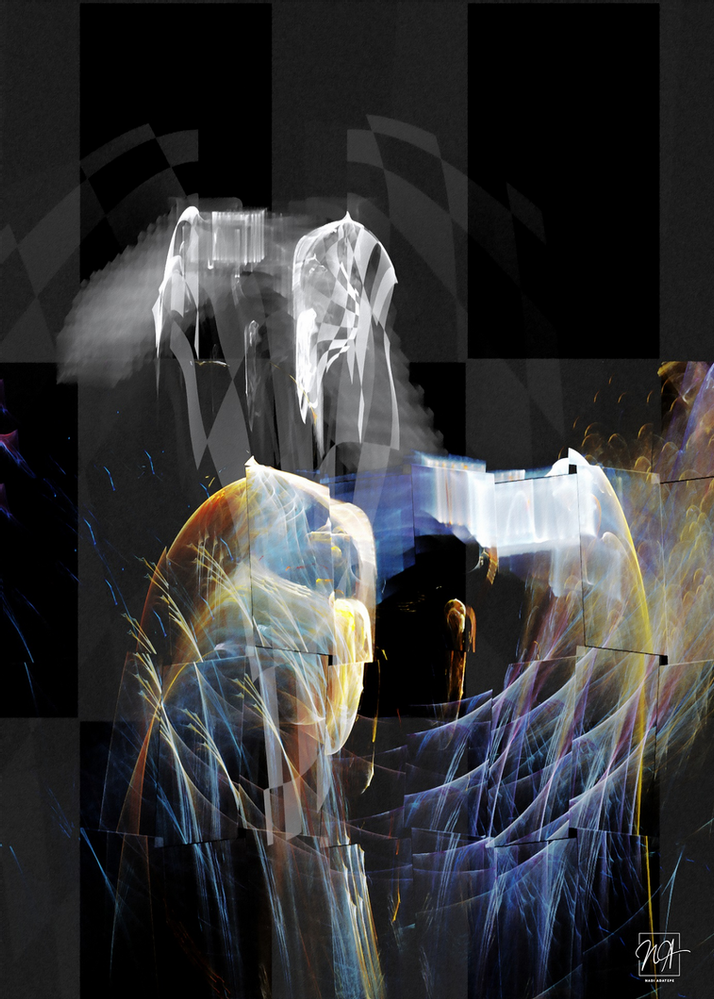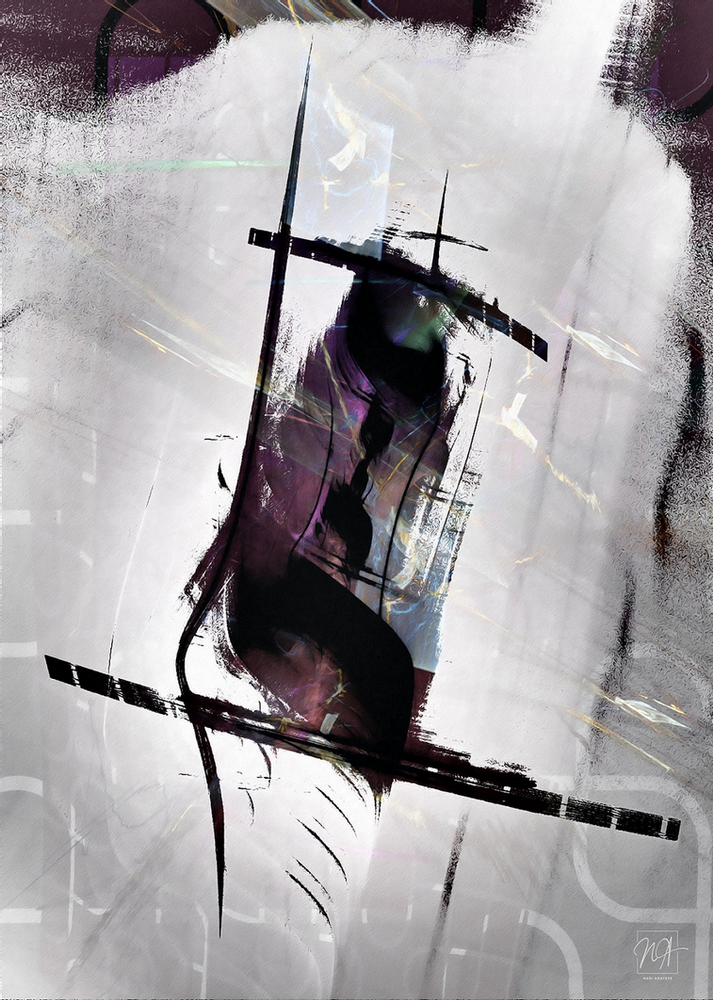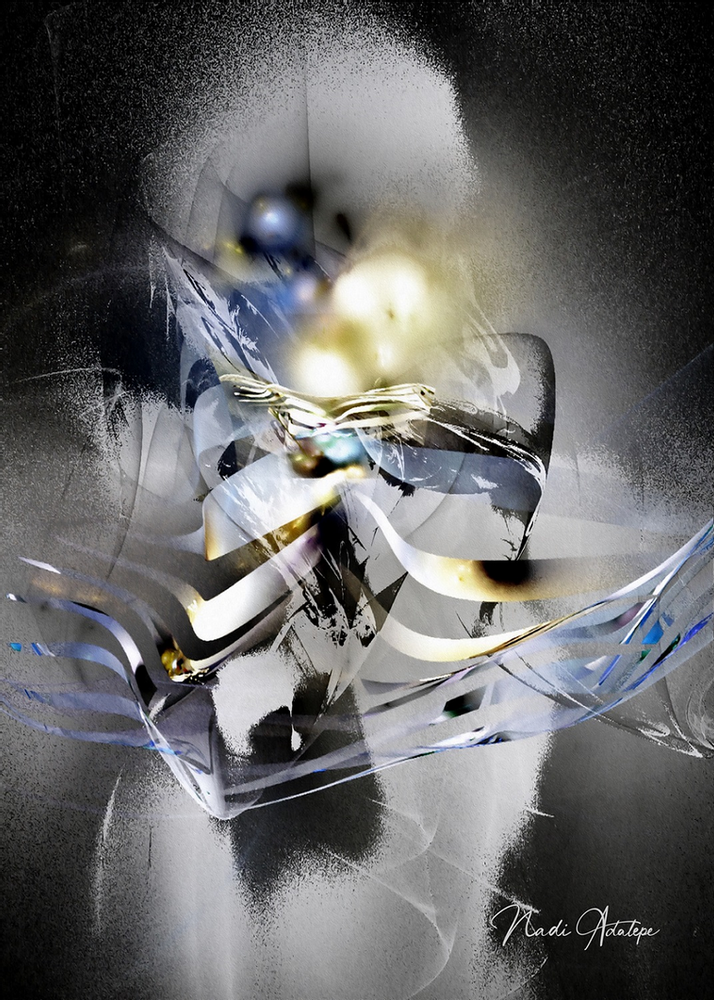
Nadi Adatepe
La Digital Art è un’evoluzione della Computer Art teorizzata e concretizzata a metà del Novecento dai matematici e programmatori Ben Laposki, statunitense, e Manfred Frank, tedesco, affascinati dalle infinite possibilità che potevano scaturire da un semplice formula matematica e le potenzialità che i nuovi apparecchi tecnologici erano in grado di dare in ogni campo; le loro ricerche e sperimentazioni hanno gettato le basi per tutto ciò che è venuto dopo, dando vita a un vero e proprio stile artistico che attualmente è entrato di diritto nelle case d’asta più importanti, come il recente successo di Beeple, che ha assistito all’aggiudicazione di un’opera completamente digitale e non stampata per quasi ottanta milioni di dollari, ha dimostrato. L’artista norvegese di origini turche Nadi Adatepe sceglie la Digital Art per esprimere emozioni, sensazioni, ricordi ma anche punti di vista che nel corso della sua vita ha elaborato, prendendo gli eventi come momento di crescita e di formazione e lasciando alle sue opere l’elaborazione dei concetti di ciò che altrimenti sarebbe rimasto silente nella sua interiorità. Il percorso per giungere allo stile attuale è stato lungo e tortuoso, ha dovuto tentare diverse strade espressive prima di scoprire quale fosse quella più affine alla propria natura e in grado di lasciar fuoriuscire il proprio pensiero filosofico, un approccio alla vita che riesce a tracciare le sue linee proprio in virtù della libertà, espressiva e interpretativa, che lascia all’osservatore. Apre domande Nadi Adatepe, permette a chi osserva i suoi lavori di riflettere su se stesso e di avvicinarsi alla risposta solo basandosi sul proprio modo di essere, di ragionare, sul percorso effettuato fino a quel momento e sulle esperienze di cui si è riempita la sua vita. Un approccio socratico dunque quello di questo interessante artista, un modo di condurre il fruitore verso il mondo delle possibilità, della realtà quantica, dell’energia che dalle sue opere scaturisce e che non può non fuoriuscire all’esterno. Attraverso i frattali Adatepe crea immagini, la sua tecnica non va a modificare una realtà preesistente, non altera l’immagine reale attraverso distorsioni o ritocchi più o meno incisivi, niente di tutto questo, lui lascia fuoriuscire ciò che il suo impeto artistico gli suggerisce a cui poi dà un’interpretazione personale, ma comunque aperta all’altro, con i titoli che sono evocativi del percorso di conoscenza da intraprendere. The Nest (Il nido)

The nest
evoca la riflessione su quanto l’uomo contemporaneo senta il bisogno di sentirsi protetto a discapito di un rischio che però potrebbe essere un’apertura, una spinta propulsiva migliore di quella in cui l’individuo si trova; d’altro canto è proprio a causa delle incertezze esterne ed esistenziali che si sente il bisogno di proteggere un’interiorità a volte troppo fragile per essere esposta. Così come in Memories

Memories
l’artista sembra suggerire all’osservatore di fare i conti con il proprio passato, quel bagaglio in alcuni casi pesante ma in fondo necessario all’evoluzione che ne è seguita, quel groviglio di emozioni apparentemente dimenticate eppure pronte a saltar fuori non appena una circostanza del presente si dimostra simile o vicina a quella del passato; e al tempo stesso è grazie ai ricordi che le persone uscite dalla vita di ciascuno restano in qualche modo vicine, o che il legame con ciò che si è stati prima del cambiamento resta forte e incancellabile, o ancora che spesso il ricordo è tutto ciò che resta nel momento di disorientamento che precede un nuovo percorso. Dunque un mondo di possibilità, di interpretazioni, di soggettività quello di Nadi Adatepe, che andremo a conoscere più fondo attraverso la sua viva voce.
Lei ha sempre sentito una forte indole artistica, ma è riuscito solo tardi a riconoscere quale fosse la manifestazione creativa più adatta a lei. Ci può raccontare quanto è stato tortuoso il percorso e come è giunto a scegliere l’Arte Digitale?
Il mio viaggio per diventare un artista è il risultato di tentativi falliti, di esprimermi attraverso la scrittura di poesie e la composizione di musica. Avevo bisogno di avere un’ancora a cui aggrapparmi nella vita, per combattere la sconfitta e risorgere. È stato questo percorso che mi ha portato a giungere a questo tipo di arte. La mia arte è la storia di tutto ciò che ho passato nella vita e di come percepisco tutto ciò che è accaduto e gli eventi che mi circondano

Alice
Qual è il messaggio filosofico che desidera far fuoriuscire dalle sue opere?
La risposta a questa domanda è anche in parte la risposta al mio interesse per le creazioni frattali e per la Concezione reciproca. La mia filosofia e il mio approccio alla realtà si basano sul fatto che credo che nulla esista nel modo in cui lo percepiamo, e quindi dovremmo cercare di pensare più in profondità. Ogni individuo in un gruppo di persone avrà sempre percezioni e comprensioni diverse sulla stessa cosa. Ciò che ognuno individualmente percepisce e comprende, non sarà dunque lo stesso di quello di un altro. Ciascuno è unico a causa dei diversi background ed esperienze di vita.
Quando guardiamo un’opera, siamo influenzati da ciò che ci è già stato detto sull’artista e sulla sua arte, e abbiamo già incorporato pensieri su come dovrebbe essere l’opera, su cosa ci dice. Questo vale anche se vogliamo creare perché tutto è già predeterminato e la maggior parte degli artisti sceglie di seguire quel percorso invece di sfidarlo, in qualche modo lo vede come una cassaforte che gli dà la sicurezza di non finire fuori dal coro, è rassicurante. Queste norme, questi pensieri compulsivi incorporati, influenzano e determinano la nostra percezione comune.
Dal momento che mi definisco un espressionista astratto digitale e / o realista, andare oltre è la parola chiave delle mie opere. Ciò che conta davvero per me è toccare i pulsanti interni, quelli che spesso hanno bisogno di essere stimolati per fuggire dal luogo sicuro in cui l’uomo contemporaneo tende a rifugiarsi. La cosa più importante dietro il mio lavoro è cercare di pensare fuori dagli schemi, esplorare i confini tra ciò che è generalmente accettato e quelli che cadono al di fuori. Si tratta solo di cercare di descrivere le cose, in un modo diverso! Le mie opere parleranno individualmente a ogni osservatore e daranno il via a un’esperienza e interpretazione personali.

Search (Ricerca)
Ci spiega nel dettaglio cos’è la sua tecnica che ha denominato Concezione reciproca?
Nella tecnica della Concezione reciproca utilizzo creazioni frattali basandomi sul mio particolare interesse nel creare arte digitale con questa modalità si fonda sul fatto che credo che nulla esista nel modo in cui lo percepiamo, e tutto ciò che esiste, o il suo manifestarsi alla conoscenza e allo sguardo può essere riprodotto attraverso la ripetizione della particella più piccola, forme semplici come appunto i frattali. Questo mio pensiero filosofico è la forza trainante della mia arte visiva, è stata cruciale per tutto il mio percorso creativo. La Concezione reciproca descrive l’interazione logica, la combinazione tra due o più creazioni frattali che vengono generate con tecniche e stili diversi, in cui ciascuna di esse beneficia del risultato dando origine a qualcosa di nuovo, qualcosa al di fuori dei concetti tradizionali pur senza perdere la propria identità. Per spiegare in modo più semplice, utilizzo più immagini frattali e le elaboro in molteplici dimensioni con i diversi plug-in, per ottenere il risultato finale. È esattamente lo stesso processo di qualsiasi altro utilizzo nell’arte digitale, tranne per il fatto che uso i frattali invece dei pennelli digitali.

The Flodd (L’alluvione)
Quanto è importante un atteggiamento di apertura, e dunque possibilista, nella vita e di conseguenza nella sua arte?
Credo che le persone che hanno la mente aperta siano più disposte a provare cose nuove, ai cambiamenti, nuove idee ed esperienze. Si avvicinano alle novità con curiosità invece di negarle o temerle. Questo atteggiamento si riflette sulla mia arte poiché non ho bisogno di limitarmi alle norme date e mi rende libero di creare arte in un modo diverso. Allo stesso tempo è anche uno stimolo a cercare più a fondo dentro di me per dar vita a nuove esperienze e pensieri creativi.
Ci racconta i prossimi progetti e i risultati ottenuti grazie alla sua affascinante e coinvolgente produzione creativa?
Devo ammettere che il 2021 è iniziato abbastanza bene per me e ha ricevuto molti premi oltre ad avere in programma una mostra a Roma. Ho ricevuto la medaglia di bronzo per l’Arte Digitale al concorso annuale d’arte della Mondial Art Academia International Art Professionals Awards 2020; il certificato di eccellenza al Palm Art Award 2020; pubblicazione sull primo numero di Art Ideal Magazine della Circle Art Foundation; il Premio Internazionale Dante Alighieri a cura di Salvatore Russo; pubblicazione su “The Best Modern and Contemporary Artists 2021” dell’Associazione EA; mostra tripersonale a cura di Anna Isopo presso la Arte Borgo Gallery di Roma. E poi ho in programma la partecipazione alla mostra collettiva internazionale Meet Art in Copenhagen curata da Marta Lock; la mostra Nemi Biennale: BIARTEN4 e una presso la galleria Effetto Arte di Palermo curata da Salvatore Russo.
NADI ADATEPE-CONTATTI
Email: nadi.adatepe@gmail.com
Sito web: https://circle-arts.com/nadi-adatepe/
Facebook: https://www.facebook.com/nadi.adatepe
Instagram: https://www.instagram.com/nadiadatepe/
Marta Lock’s interviews:
Nadi Adatepe, Digital Art as a philosophical concept of life
Digital Art is an evolution of Computer Art theorised and realised in the mid-twentieth century by mathematicians and programmers Ben Laposki, from the United States, and Manfred Frank, from Germany, who were fascinated by the infinite possibilities that could arise from a simple mathematical formula and the potential that the new technological devices were able to provide in every field. Their research and experiments laid the foundations for everything that came later, giving rise to a veritable artistic style that has now rightfully entered the top auction houses, as the recent success of Beeple, which saw a completely digital, unprinted work go for almost eighty million dollars, has shown. The Norwegian artist of Turkish origin, Nadi Adatepe, chooses digital art to express emotions, sensations, memories but also points of view that he has elaborated over the course of his life, taking events as a moment of growth and formation and leaving his works to elaborate the concepts of what would otherwise have remained silent in his interiority. The path to his current style has been long and tortuous, and he has had to try out different expressive paths before discovering which was the one most akin to his nature and capable of allowing his philosophical thought to emerge, an approach to life that succeeds in drawing its lines precisely by virtue of the freedom of expression and interpretation that he leaves to the observer. By opening up questions, Nadi Adatepe allows the observer of his artworks to reflect on himself and to approach the answer only on the basis of his own way of being, of reasoning, of the path he has followed up to that moment and of the experiences with which his life has been filled. A Socratic approach then, that of this interesting artist, a way to lead the viewer to the world of possibilities, quantum reality, energy that springs from his artworks and that can not fail to come out. Through fractals Adatepe creates images, his technique does not go to change a pre-existing reality, does not alter the real image through distortions or touches more or less incisive, none of this, he lets out what his artistic impetus suggests to which then gives a personal interpretation, but still open to the other, with the titles that are evocative of the path of knowledge to be undertaken. The Nest evokes a reflection on the extent to which contemporary man has the need to feel protected to the detriment of a risk that could, however, be an opening, a better driving force than the one in which the individual finds himself; on the other hand, it is precisely because of external and existential uncertainties that we feel the need to protect an interiority that is sometimes too fragile to be exposed. Just as in Memories, the artist seems to suggest that the observer should come to terms with his own past, that baggage which in some cases is heavy but in the end necessary for the evolution that has followed, that tangle of emotions apparently forgotten but ready to surface as soon as a circumstance in the present proves to be similar or close to that of the past; and at the same time it is thanks to memories that people who have left one’s life remain somehow close, or that the link with what one was before the change remains strong and indelible, or that often the memory is everything that remains in the moment of disorientation that precedes a new path. So that of Nadi Adatepe is a world of possibilities, interpretations and subjectivity, which we will get to know in depth through his own voice.
You have always felt a strong artistic nature, but only later you were able to recognise which was the most suitable creative manifestation for you. Can you tell us how tortuous the path was and how you came to choose Digital Art?
My journey to become an artist is the result of failed attempts to express myself through writing poetry and composing music. I needed to have an anchor to hold onto in life, to fight defeat and rise again. It was this path that led me to reach this type of art. My art is the story of everything I have been through in life and how I perceive everything that has happened and the events that surround me.
What is the philosophical message you want to get across in your work?
The answer to this question is also partly the answer to my interest in fractal creations and Reciprocal conception. My philosophy and my approach to reality are based on the fact that I believe that nothing exists in the way we perceive it, and therefore we should try to think deeper. Each individual in a group of people will always have different perceptions and understandings about the same thing. What each individually perceives and understands, will therefore not be the same as that of another. Each one is unique because of the different backgrounds and life experiences. When we look at an artwork, we are influenced by what we have already been told about the artist and his art, and we have already incorporated thoughts on how the artwork should be, on what it tells us. This is also true if we want to create because everything is already predetermined and most of the artists choose to follow that path instead of challenging it, somehow they see it as a safe that gives them the security of not ending up out of the chorus, it’s reassuring. These norms, these embedded compulsive thoughts, influence and determine our common perception. Since I define myself as a digital abstract expressionist and / or realist, going beyond is the key word of my works. What really matters to me is to touch the internal buttons, the ones that often need to be stimulated to escape from the safe place where contemporary man tends to take refuge. The most important thing behind my artworks is to try to think outside the box, explore the boundaries between what is generally accepted and what falls outside. It’s just about trying to describe things, in a different way! My works will speak to each observer individually and kickstart a personal experience and interpretation.
Can you tell us in detail what your technique is, which you call Mutual Conception?
In the technique of Mutual Conception I use fractal creations based on my particular interest in creating digital art in this way is founded on the fact that I believe that nothing exists in the way we perceive it, and everything that exists, or its manifestation to knowledge and look can be reproduced through the repetition of the smallest particle, simple shapes such as fractals. This philosophical thought of mine is the driving force of my visual art, it has been crucial for my entire creative journey. The Reciprocal Conception describes the logical interaction, the combination between two or more fractal creations that are generated with different techniques and styles, in which each of them benefits from the result giving rise to something new, something outside the traditional concepts even without losing their identity. To explain in a simpler way, I use many fractal images and process them in multiple dimensions with the different plug-ins, to get the final result. It’s exactly the same process as any other use in digital art, except I use fractals instead of digital brushes.
How important is an attitude of openness, and therefore possibilist, in life and consequently in your art?
I believe that people who have an open mind are more willing to try new things, changes, new ideas and experiences. They approach news with curiosity instead of denying or fearing them. This attitude is reflected in my art because I do not need to limit myself to the given norms and gives me the freedom to create art in a different way. At the same time it is also an incentive to look deeper within myself to create new experiences and creative thoughts.
Can you tell us about your forthcoming projects and the results achieved thanks to your fascinating and engaging creative production?
I have to admit that 2021 has started off quite well for me and received many awards as well as having an exhibition planned in Rome. I received the bronze medal for Digital Art at the annual Mondial Art Academia International Art Professionals Awards 2020; the certificate of excellence at the Palm Art Award 2020; publication in the first issue of Circle Art Foundation’s Art Ideal Magazine; the International Dante Alighieri Award curated by Salvatore Russo; publication in The Best Modern and Contemporary Artists 2021 by the EA Association; a three-person exhibition curated by Anna Isopo at the Arte Borgo Gallery in Rome. I am also planning to take part in the international group exhibition Meet Art in Copenhagen curated by Marta Lock; the Nemi Biennale exhibition: BIARTEN4 and one at the Effetto Arte gallery in Palermo curated by Salvatore Russo.
NADI ADATEPE-CONTACTS
Email: nadi.adatepe@gmail.com
Sito web: https://circle-arts.com/nadi-adatepe/
Facebook: https://www.facebook.com/nadi.adatepe
Instagram: https://www.instagram.com/nadiadatepe/
